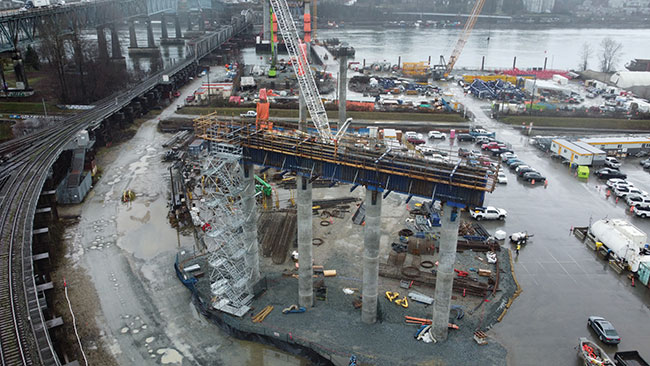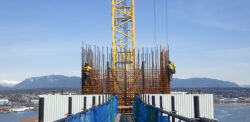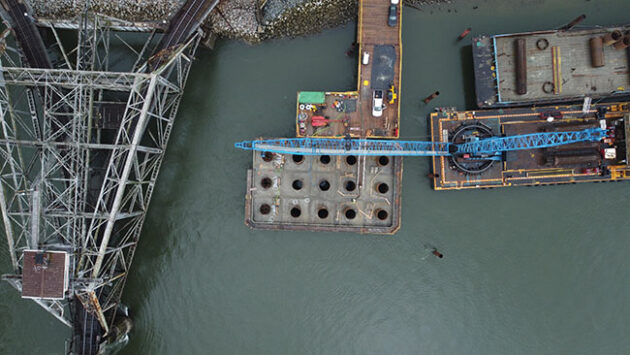
Features
Roads & Bridges
Bridging the gap on the Fraser River
B.C. is using modern techniques to replace the Pattullo Bridge, reducing the impact on residents and the environment.
September 4, 2023 By Grant Cameron
 Aerial view of a bridge pier in Surrey.
All photos courtesy of B.C. Ministry of Infrastructure.
Aerial view of a bridge pier in Surrey.
All photos courtesy of B.C. Ministry of Infrastructure. A small army of operators on tower, crawler and rough-terrain cranes along with excavators, dozers and other heavy equipment has descended on the shores of the Fraser River between Surrey and New Westminster, B.C., where a new, $1.38 billion crossing is being built to replace the existing Pattullo Bridge.
The toll-free, modern, four-lane structure is being constructed upstream and northeast of the existing bridge. It will have one pier and a single main tower in the river channel, reduced from six piers for the current structure.
Fewer in-river supports result in less construction activity and infrastructure in the river, minimizing the impacts on aquatic habitat and making for easier navigation of the river for boaters.
Pile installation was recently completed for the in-river foundations. Twenty-seven piles were installed over a six-month period for one foundation and another 15 were anchored in place over five months in 2022 for the other.
In New Westminster, site prep continues and work is under way on an overpass rehabilitation and street intersection. Work on the bridge foundation and piers will continue.
In Surrey, pile installation has started for off-ramp foundations and a road overpass. Upcoming activities include continued construction of the bridge foundations and ongoing site preparation and road work along 112 Avenue.
In addition to the main bridge foundations, a total of eight off-ramp foundations are being built – one in New Westminster near the McBride Boulevard-East Columbia Street intersection, and seven for the off-ramp between the bridge and Highway 17 in Surrey.
There are also five foundations for a multi-use path (MUP) ramp being built in Surrey and three foundations for an MUP ramp in New Westminster.
“Construction of the bridge tower is progressing well,” says Wendy Itagawa, executive project director of the Pattullo Bridge Replacement Project. “There will be a total of 33 lifts for each leg of the tower. We have completed 20 lifts on the east leg and 20 lifts on the west leg of the tower and have completed the lower crossbeam.”
This year, construction of the tower legs will continue along with building an upper crossbeam. Crews will also start to install steel girders and begin putting in concrete deck panels and stay cables.
The workforce fluctuates depending on the work being done. There are currently about 400 workers on site. It is estimated the project will create more than 7,000 direct and indirect jobs over the life of the venture.
The main in-river tower will stand 167 metres high once complete. The two legs of the tower are being built through a series of segment jumps. Once forms are set in place, rebar is installed and concrete is poured, then the forms are opened and jumped five metres. This process is repeated all the way to the top of the tower.
Crews have built temporary fixed-access platforms. Barges are also being used to bring materials to the site.
On Budget and on time
Fraser Crossing Partners is building the crossing. The team includes Acciona Construction S.A., Acciona Infrastructure Canada Inc., Aecon Group Inc., Aecon Constructors, Leonhardt, Andra and Partner Beratende Ingenieure VBI AG, Hatch Corporation, and EXP Services Inc.
According to a statement prepared for Rock to Road by the B.C. Ministry of Transportation and Infrastructure, construction is progressing well and the project remains on schedule and budget – unlike in Manitoba where the price tag for the St. Vital Twin Bridges rehabilitation project has gone up by $6.1 million, or 14 per cent, partly to cover the cost of structural underpinning and slope stability measures due to recent movement of the bridge pier on the north riverbank.
A modern approach to pile installation
Pile installation has been a key part of the Pattullo Bridge Replacement Project.

Crews working inside the main bridge tower’s east leg to install reinforcing rebar.
In New Westminster, a drilled shaft methodology was used instead of intermittent pile driving, to minimize noise and vibration for nearby residents.
In Surrey, crews would drive a steel pile into the ground, then stop to weld another steel pile section onto the driven pile, and then start up again until the pile reached the required depth.
After the steel pile was driven or drilled into the ground, it was filled with rebar, followed by concrete to fill and “plug” the pile.
The timing and placement of the in-river piling has been a big deal. The work took place during the “least risk window,” which is from mid-June to the end of January, after freshet flows subside, to protect fish.
Determining the hydraulic effect the bridge would have on the river was an essential part of the planning process, as the Fraser River is an important ecosystem for many marine species like salmon and sturgeon.

View of the future New Westminster bridge approach.
A team studied how the bridge would impact other downstream structures, the way the river would flow, and where sedimentation and scour would take place.
“It’s the longest river in B.C. with high water-flow velocities, particularly at this location,” says Itagawa. “The bridge hydraulic effects have been a key design element to ensure no adverse impacts due to scour and sedimentation on downstream structures and navigation channels.”
As part of the project, the team built a 1:80-scale model of the foundations in a lab to test different hydraulic scenarios. Numerical modeling was also used to check the design. A number of scenarios, were run, including peak river flows and record floods, to determine the best place for bridge infrastructure.
“A major consideration in the construction of the bridge is protecting aquatic life of the river, including the need to have as little impact on it as possible as per various provincial and federal regulatory permits,” notes Itagawa.
To minimize disturbance to fish during in-river bridge foundation works, the contractor used an underwater noise mitigation system. This system included a confined bubble-curtain system which has underwater tubes that release a wall of bubbles to dissipate the noise around the pile driving work areas. The air acts as an absorber and reflector of the sound waves.
The project went through both provincial and federal environmental assessments and permitting processes. The assessments reviewed many aspects of the potential environmental and social impacts of the project, including fish and fish habitat, marine use and navigation, archaeology, traffic, and potential noise.

Aerial view of a pier on the New Westminster side.
Built to last
Because B.C. is prone to earthquakes, the bridge replacement is designed to last 100 years and is being built to modern seismic standards.
Itagawa says there have been a number of challenges to the project, one being that construction work had to be co-ordinated around the opening and closing of a rail swing bridge which is approximately 50 metres away.
The Fraser River is an active marine transportation route supporting B.C.’s economy. It has commercial marine traffic supporting many industries as well as Indigenous fishing and marine use. A navigation protection zone was developed in consultation with the port, marine users, and Transport Canada.
“Keeping the transportation channels maintained during active construction has been critical,” says Itagawa. “Our contractor works closely with Transport Canada and marine users to keep marine traffic informed through regular updates.”
The bridge was supposed to open this year but on-site investigative work and permitting processes took longer than anticipated due to the complexities of the project and challenges presented by the COVID-19 pandemic.
The bridge is now scheduled to open in 2024. The replacement was deemed necessary as the existing Pattullo Bridge, which opened in 1937, does not meet modern design standards. Traffic lanes are too narrow and the bridge requires lane closures at night for safety. It only has one narrow sidewalk with no protection from traffic.
The existing bridge will be demolished when the new one opens.
Once completed, the bridge will improve safety and reliability for drivers, cyclists and walkers, as well as the movement of goods, and better connect Surrey and New Westminster with modern, wider lanes.
The project is being delivered under the province’s Community Benefits Agreement (CBA). The CBA prioritizes hiring local workers, including Indigenous Peoples, women, people with disabilities and other under-represented groups who are qualified to do the work, in a safe, welcoming work environment.
The idea is geared to diversifying and growing B.C.’s skilled workforce by providing opportunities for Red Seal apprentices to work on site and gain the experience they need to launch good careers in the trades.
Print this page